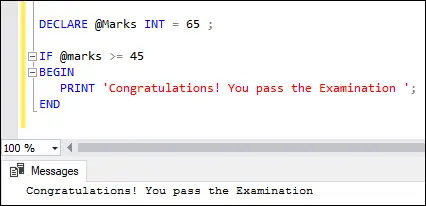IF-sætningen er en del af kontrolflowfunktionen i SQL Server. Normalt er det en beslutningserklæring på forskellige programmeringssprog, der returnerer en værdi baseret på de givne betingelser . Denne sætning udfører koden skrevet i IF-blokken, når den givne betingelse evalueres til sand, og når betingelsen evalueres falsk, vil ELSE-sætningen blive udført.
IF-erklæringen
Følgende er syntaksen, der illustrerer brugen af denne sætning i SQL Server:
IF boolean_expression BEGIN { statement_block } END I ovenstående syntaks er statement_block i BEGYND...SLUT blok udføres, når boolesk_udtryk er tilfreds med tilstanden. Ellers springes denne blok over, og programstyringen flyttes til sætningen efter ENDE søgeord. Vi bør vide, at hvis udtrykket indeholder en VÆLG erklæring, er vi nødt til sæt dem i parentes .
binært søgetræ]
Eksempel
Lad os se eksemplet for at forstå IF-sætningen uden ELSE-blok. Nedenstående eksempel vil vise resultatet, når betingelsen er opfyldt. Ellers flyttede programkontrollen til sætningen efter nøgleordet END, hvis nogen.
DECLARE @Marks INT = 65 ; IF @marks >= 45 BEGIN PRINT 'Congratulations! You pass the Examination'; END
Udførelse af sætningen vil give følgende output:

Nu vil vi demonstrere det på nedenstående ' Studerende' tabel med følgende data:

Nedenstående er et andet eksempel, der får samlede karakterer af en udvalgt elev fra ' Studerende' tabel i eksempeldatabasen og udskriver derefter en besked hvis det er mere end 400 .
BEGIN DECLARE @Total_Marks INT; SELECT @Total_Marks = total_marks FROM Student WHERE age>25; SELECT @Total_Marks; IF @Total_Marks > 400 BEGIN PRINT 'Congratulations! You pass the Examination'; END END
Vi får nedenstående output:

Hvis vi ønsker at se ovenstående outputmeddelelse, skal vi klikke på Beskeder fane:

IF-ELSE-erklæringen
I scenariet i den virkelige verden er vi nødt til at udføre en handling, når betingelsen i IF-sætningen er TRUE eller FALSE. I dette tilfælde er IF…ELSE-sætningen nyttig. Denne sætning udfører ELSE-sætningsblokken, når betingelsen i IF-sætningen evalueres FALSE.
Det følgende er syntaksen, der illustrerer brugen af IF ELSE-sætningen i SQL Server :
IF expression BEGIN Statement block -- It executes when the IF clause expression is TRUE. END ELSE BEGIN Statement block -- It executes when the IF clause expression is FALSE. END
Eksempel
Lad os se eksemplet for at forstå IF-sætningen med ELSE-blok. Nedenstående eksempel vil vise meddelelsen ' Tillykke! Du består eksamen ', når IF-betingelsen er opfyldt. Ellers skal du vise ' Du er fejlet! Bedre held næste gang '.
DECLARE @Marks INT; SET @Marks = 65; IF @marks <45 begin print 'congratulations! you pass the examination'; end else 'you are failed! better luck next time'; < pre> <p>Executing the statement will give the below output. Here, the <strong>marks</strong> variable is <strong>65</strong> , and the <strong>condition (65<45)< strong> is not satisfied. Therefore, the message inside the ELSE block is displayed:</45)<></strong></p> <img src="//techcodeview.com/img/sql-server-tutorials/49/sql-server-if-else-5.webp" alt="SQL Server IF ELSE"> <p>We will get this output because the condition <strong>(65>45)</strong> is satisfied. Therefore, the message inside the IF block is displayed:</p> <img src="//techcodeview.com/img/sql-server-tutorials/49/sql-server-if-else-6.webp" alt="SQL Server IF ELSE"> <p>Now, we will demonstrate the IF ELSE statement on the above ' <strong>Student'</strong> table. In this example, we are going to check whether the student <strong>total marks</strong> is <strong>greater than or equal to 400</strong> or not as follows:</p> <ul> <li>When the IF condition is TRUE, we will get the student records whose total marks are greater than or equal to 550.</li> <li>If the condition is FALSE, we will get the student records whose total marks are less than 550.</li> </ul> <p>Here is the program:</p> <pre> DECLARE @Marks INT; SET @Marks = 600 ; IF @Marks >= 550 BEGIN SELECT id, name, gender, age, total_marks FROM Student WHERE total_marks >= 550 ORDER BY age ASC END ELSE BEGIN SELECT id, name, gender, age, total_marks FROM Student WHERE total_marks <550 order by age asc end < pre> <p>In this code, we have specified the <strong>@Marks</strong> variable to <strong>600</strong> , and the condition (600 >= 550) is satisfied. Therefore, we will get the output where student records whose total marks are greater than or equal to 550 are displayed.</p> <img src="//techcodeview.com/img/sql-server-tutorials/49/sql-server-if-else-7.webp" alt="SQL Server IF ELSE"> <p>If we changed the <strong>@Marks</strong> variable to <strong>500</strong> and the condition (500 >= 550) becomes false. Therefore, we will get the output where student records whose total marks are less than 550 are displayed.</p> <img src="//techcodeview.com/img/sql-server-tutorials/49/sql-server-if-else-8.webp" alt="SQL Server IF ELSE"> <h2>Nested IF ELSE Statement</h2> <p>Unlike other programming languages, we can nest an IF...ELSE statement inside another IF...ELSE statement in SQL Server. Let us demonstrate it with the following example:</p> <pre> DECLARE @age INT; SET @age = 6; IF @age <18 50 print 'you are underage'; else begin if @age < below 50'; senior cetizen'; end; pre> <p>In this example, we are going to check whether the <strong>age is underage, below 50, or senior citizen</strong> as follows:</p> <ul> <li>If the value of the <strong>@age</strong> variable is below <strong>18</strong> , it will print the person is <strong>underage</strong> .</li> <li>If the condition is FALSE, the ELSE part will be executed that has a nested IF…ELSE.</li> <li>If the value of the <strong>@age</strong> variable is under <strong>50</strong> , it will print <strong>below 50</strong> . Finally, if no condition is satisfied, it will print <strong>senior citizens</strong> .</li> </ul> <p>Here is the result:</p> <img src="//techcodeview.com/img/sql-server-tutorials/49/sql-server-if-else-9.webp" alt="SQL Server IF ELSE"> <p>This article gives a complete overview of how to use the SQL Server IF ELSE statement. Here we have learned:</p> <ul> <li>Variables are objects that serve as placeholders.</li> <li>The keyword BEGIN will be used to start a statement block, and the END keyword must be used to close it.</li> <li>The use of ELSE in an IF... ELSE statement is optional.</li> <li>It's also possible to nest an IF...ELSE statement inside another IF...ELSE statement. However, nesting an IF statement within another statement is bad practice because it makes the code difficult to read and maintain.</li> </ul> <hr></18></pre></550></pre></45>
